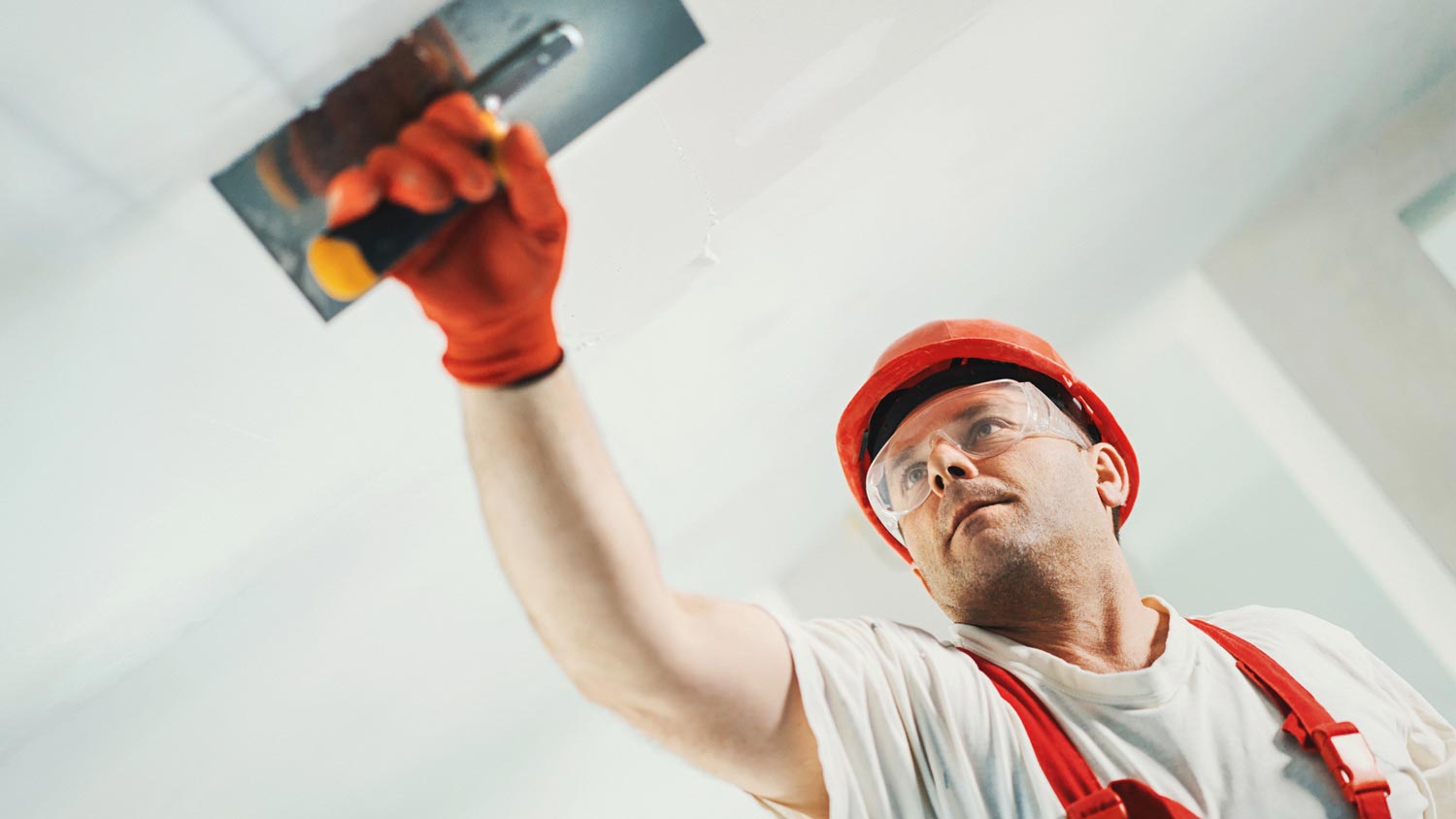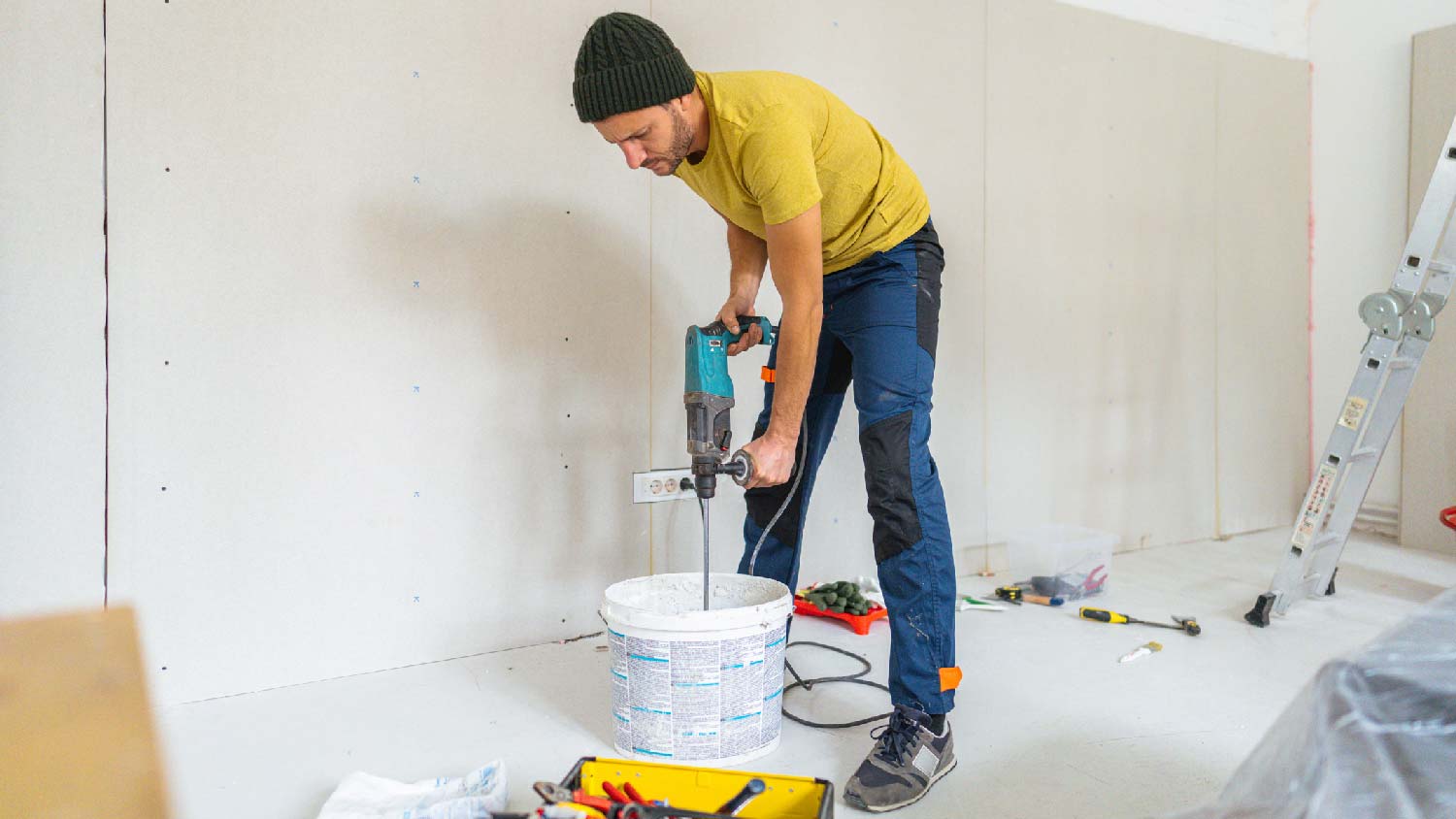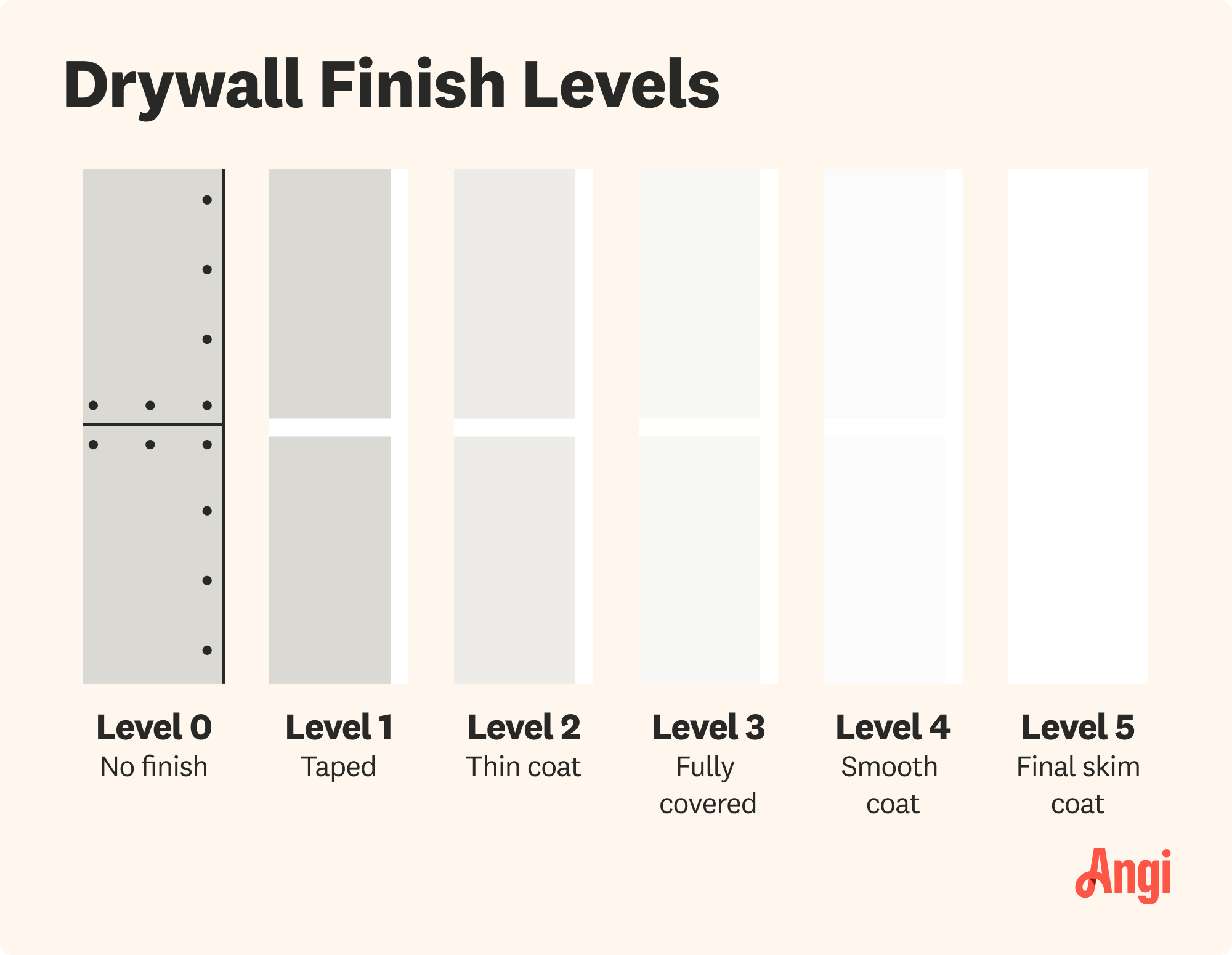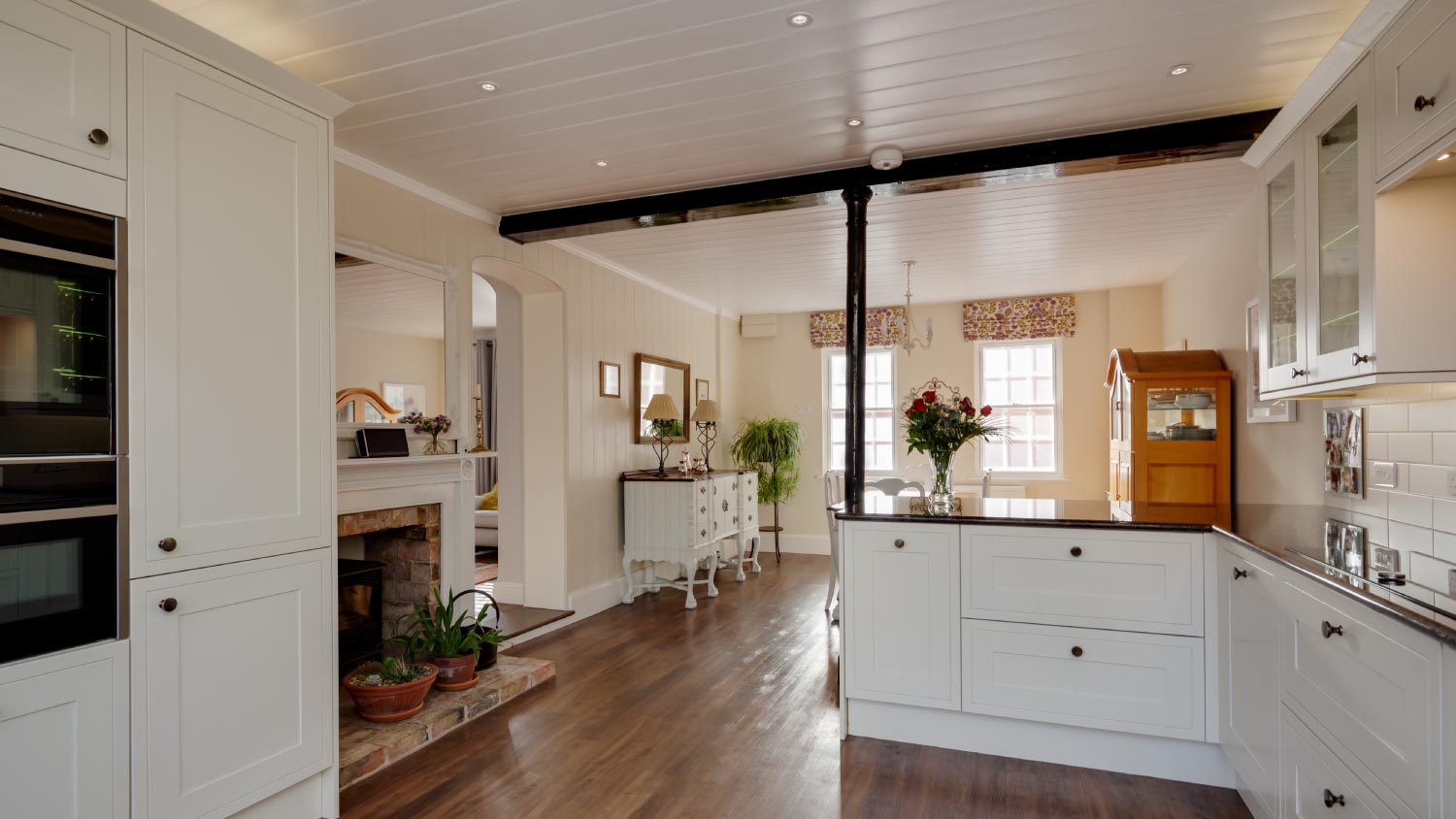
Skim coating drywall is a great alternative to replacement, and is often more affordable. Use this guide to estimate the cost to skim coat walls in your home.
Learn some smooth moves for your new walls


Most visible walls need at least three coats of drywall mud.
One or two coats of drywall mud can work in hidden or utility spaces.
Skim coating before mudding adds a smooth, paint-ready finish.
You’ll need fewer coats of drywall mud if you’re adding tile or panels over the drywall.
Drywall mudding takes a lot of patience for a pro-level look, so consider hiring a pro.
When tackling DIY drywall installation, one of the most common questions is how many coats of mud on drywall you actually need. The short answer is three coats for most walls. The long answer is that it depends on where the wall is and how it will be used when it’s done. Most visible interior walls need a minimum of three coats of mud—and then an additional skim coat if you want a truly flawless finish. However, for less public areas or utility spaces, you may be able to get away with fewer coats. Let’s dig into the details.
“Drywall mudding” refers to the process of applying joint compound, aka “mud,” over drywall seams, screw holes, and imperfections. Mudding is an important part of drywall installation since it leads to a smooth, seamless finish. It hides joints and fasteners and blends those individual drywall panels into one smooth and uniform-looking wall.
If you want a good finish on your wall, it's absolutely worth it to pay for professional taping and mudding. Many DIYers are tempted to pay someone to hang the drywall and do the rest themselves, but this is one area where a skilled contractor can make a huge difference.
The drywall mudding process involves multiple coats, sanding between coats, and careful feathering of the edges for a gorgeous, professional finish.

While three coats of mud is standard, certain factors in your project can change that number. The visibility of the space, the purpose of the room, other construction materials involved, and your desired finish all impact how many coats of drywall mud you should use.
If you're working on an attic, crawl space, or other infrequently-seen area, a single coat of mud could suffice. In these hidden spaces, function is the most important thing, while aesthetics take the back seat.
However, if the wall you’re working on is in a main living area, hallway, or other high-visibility room, you’ll want to plan for three full coats of mud—and potentially a skim coat on top. This will give the walls a smooth, professional-looking appearance.
Some spaces—including utility areas like garages and workshops—don’t need a showroom finish. In these areas, you can often get away with two coats of mud to conceal nails, screw holes, and joints.
Of course, you still want a somewhat smooth surface, but perfection isn’t crucial if the area is meant more for function than aesthetics.
Will the wall eventually be covered with another material like tile or paneling? If so, you can use fewer mud coats since these materials will mask any small imperfections in the drywall beneath. This is especially true if the surface is structurally sound and level enough to support the added wall materials. If it is, you can skip the final polishing coat.

If you want a smooth wall that looks professionally done, use three mud coats and a final skim coat. The skim coat is a thin, final application of drywall mud that smooths over any visible imperfections and creates a flawlessly finished surface.
A skim coat is especially important when you’re preparing a wall for painting. With paint, the smallest blemishes can become glaring under a fresh coat of color.
There’s a method to the madness when it comes to mudding drywall, and each coat of mud serves a distinct purpose. Here are the three basic coats and what you should know about their purposes:
Bedding the tape (coat one): This first layer embeds the joint tape over all the seams and also covers screw holes and nail heads. It’s the thickest coat and sets the foundation for all of your additional coats.
Covering the tape (coat two): The second mud coat covers the joint tape and widens the joint to blend it into the wall. This layer helps eliminate sharp edges and visible ridges in the panels.
Skim coating (coat three): The final coat smooths out any remaining imperfections and feathers out the edges. This thin, wide coating is key for achieving a seamless, professional finish—especially before painting.
If you're aiming for that clean, smooth, polished look for your new wall, attention to detail is critical. Here are some tips to get the best product possible after your drywall mudding:
Use a wide drywall knife for the final coats to make it easier to feather the edges.
Sand between each mud coat to get rid of bumps and ridges.
Let each coat dry completely before sanding or applying the next coat.
Don't skimp on the skim coat. This last coat can make or break the final appearance.
When in doubt, hire a local drywall installer instead of DIYing your drywall mudding project. These pros have the tools and experience to get your wall perfect the first time.
I hired DNA Gates and Fences through HomeAdvisor for a driveway security gate installation at my business, and the entire experience was excellent. The team was professional, courteous, and highly skilled. They took the time to understand my security needs and recommended the best materials...
Jiovany and his team were so great from the start, at communicating then at the job, fast and dedicated. Didn’t leave until we were happy with every detail. They went far and beyond to make the place spotless and pristine. Reliable, responsible and respectful.
Very reliable extremely efficient. They helped me repair my property after water damage caused by burst pipe. They got everything repaired in a timely manner.
I contacted the chimney guys last week for an inspection and cleaning service, everything is done and thank goodness they came because they removed a lot of dirt and they told me that the person who came for maintenance last year had done nothing! So now you have my trust.
Bayside Home Improvement did an incredible job remodeling our home! They helped us reimagine the layout, update the finishes, and create a space that better suits our lifestyle. Their attention to detail and commitment to quality craftsmanship were evident throughout the entire project....
Had these guys add 850 SQFT to my home. I could not recommend them enough. Process went faster than expected and they helped out dealing with permitting in Miami which was a plus. I highly recommend them and I did not have any issues
Hiring SJZ for our ADU project was the best decision. Sammy created a brilliant design that maximized the allowable space, and his crew brought it to life beautifully. The final unit is a stunning, functional living space that is been a game-changer for our property. Could not recommend SJZ...
I turned to John for garage door repair, and he exceeded all my expectations. He arrived the same day he was called, and the work was done quickly and professionally. The prices he offered were very reasonable, and I particularly appreciate the free estimate he provided. Communicating with...
Very good communication, and they are able to get the job done in a timely fashion. Definitely recommend them if you need any help with moving.
I had a massive three bedroom house to pack up and move across the state This moving company had my back though Their customer service was top notch They kept me in the loop throughout the whole process Plus they were bang on schedule All my belongings made it in one piece Kudos to these...
From average costs to expert advice, get all the answers you need to get your job done.

Skim coating drywall is a great alternative to replacement, and is often more affordable. Use this guide to estimate the cost to skim coat walls in your home.

Installing beadboard ceilings is a great DIY project. Learn what to expect cost-wise from this project, whether removing or covering a popcorn ceiling.

Whether you’re trying to keep noise in or out, soundproofing materials are the way to go. Use this guide to see how much it costs to soundproof a room.

When hanging objects, you will use different types of drywall anchors. Use this guide to determine which anchor to use and when.

Looking to add some texture to your walls for a unique finish? Use this guide to estimate skip trowel texture cost to see if it’s the right option for you.

Texturing drywall can conceal imperfections and make your walls look a little more interesting. Want to try it? Learn how to texture drywall in this guide.